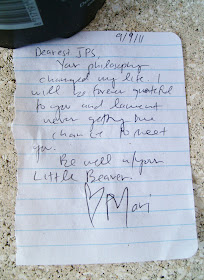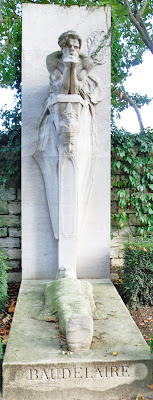Joris Karl Huysmans (1848—97), still very much remembered for his novel À rebours (1884), which the decadent Pete Doherty named a song after on Babyshambles's Down in Albion album.
Honoré Champion (1846—1913) owned a bookstore and published books under his own name. His publications had a scientific bias, although the history of literature was his specialization. Albert Bartholomé was the sculptor of his grave.
Tristan Tzara (1896—1963).
Rather messy, but maybe this is appropriate for the founder of Dadaism.
The grave of Jean-Paul Sartre (1905—80) and Simone de Beauvoir. I was slightly surprised to see them receiving the red lipstick treatment à la Serge Gainsbourg here, or Oscar Wilde in Père-Lachaise.
Dearest JPS,
Your philosophy changed my life. I will be forever grateful to you and lament not having the chance to meet you.
Be well w/your Little Beaver.
[heart symbol] Mari'.
Eugène Ionesco (1909—94). My comments on this blog on four Ionesco plays are here.
'Prier le Je Ne Sais Pas Qui
J'espère: Jésus Christ.'
['Praying for the I Don't Know Who
Jesus Christ, I hope']
Samuel Beckett (1906—89). It would have been a shock if it hadn't been a minimalist grave.
'Poète et Romancier
"tu t'enfonces dans la rose
ébloui par l'or de la nuit'.
R.B.'
Rabah Belamri (1945—95) was born in Algeria and lost his sight in 1962, on the day Algeria was declared independent. After leaving the University of Algiers, he continued his education in Paris, where he earned a doctorate on the work of Louis Bertrand Miroir, which was published several years later. He published several collections of poems and short stories and novels inspired by his Algerian childhood. He is buried with 'L'homme des voyages' Yves Rachid Lefort, although the internet doesn't seem able to tell me why that is.
Charles Baudelaire (1821—67), whose grave (which I couldn't find) is sometimes confused with this cenotaph, which was sculpted in 1902 by the same person who made Sainte—Beuve's column — Jose de Charmoy. It features a scowling Baudelaire at the head of a column.
Honoré Champion (1846—1913) owned a bookstore and published books under his own name. His publications had a scientific bias, although the history of literature was his specialization. Albert Bartholomé was the sculptor of his grave.
Tristan Tzara (1896—1963).
Rather messy, but maybe this is appropriate for the founder of Dadaism.
The grave of Jean-Paul Sartre (1905—80) and Simone de Beauvoir. I was slightly surprised to see them receiving the red lipstick treatment à la Serge Gainsbourg here, or Oscar Wilde in Père-Lachaise.
'9/9/11
Dearest JPS,
Your philosophy changed my life. I will be forever grateful to you and lament not having the chance to meet you.
Be well w/your Little Beaver.
[heart symbol] Mari'.
'Las personas mueren, las ideas no'.
['People die, ideas don't']
Eugène Ionesco (1909—94). My comments on this blog on four Ionesco plays are here.
Of note is what is written at the bottom edge of the grave:
'Prier le Je Ne Sais Pas Qui
J'espère: Jésus Christ.'
['Praying for the I Don't Know Who
Jesus Christ, I hope']
An honest rather than a flattering facial representation, by José de Charmoy, of the essayist and literary critic Sainte-Beuve (1804—69), but an extremely impressive monument.
"tu t'enfonces dans la rose
ébloui par l'or de la nuit'.
R.B.'
Rabah Belamri (1945—95) was born in Algeria and lost his sight in 1962, on the day Algeria was declared independent. After leaving the University of Algiers, he continued his education in Paris, where he earned a doctorate on the work of Louis Bertrand Miroir, which was published several years later. He published several collections of poems and short stories and novels inspired by his Algerian childhood. He is buried with 'L'homme des voyages' Yves Rachid Lefort, although the internet doesn't seem able to tell me why that is.
Guy de Maupassant (1950—93), a writer much influenced by the very popular Schopenhauer, although the French translation leaned heavily on the philosopher's more sensational theories about egoism, pessimism and misogyny. Flaubert thought Boule de suif a great work, and Maupassant saw him as a father figure. A very enthusiastic frequenter of brothels who wrote a number of stories about prostitutes, he died insane, riddled with syphilis at the age of 43.
A (slightly vandalized) bat sprawls below him. (Baudelaire is in fact buried with Jacques Aupick, the father-in-law he hated.)
And there is a mummified figure lying on the ground in front of him.


























Is it a joke that the mummy appears like a gigantic phallus?
ReplyDelete